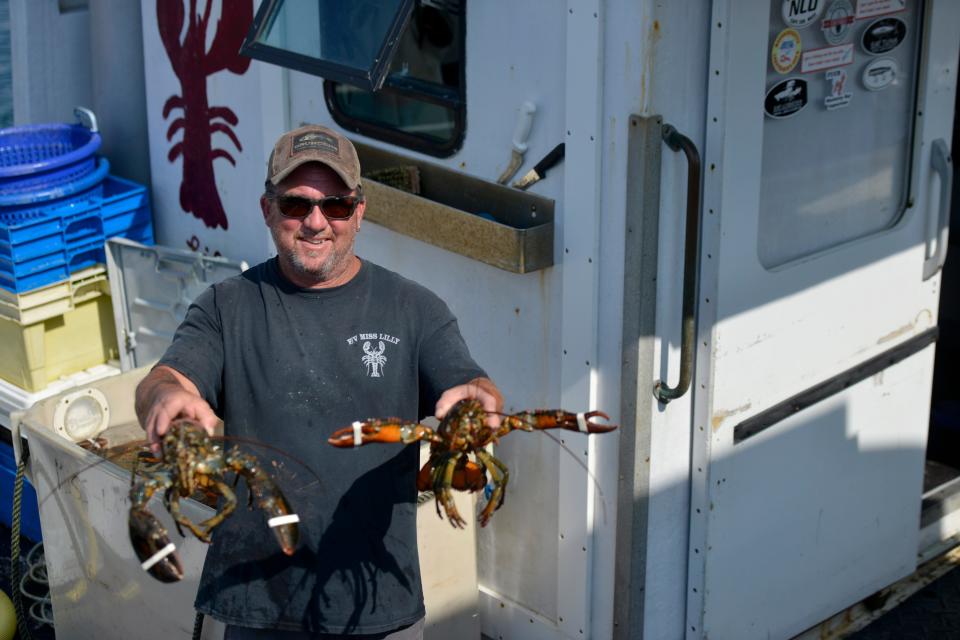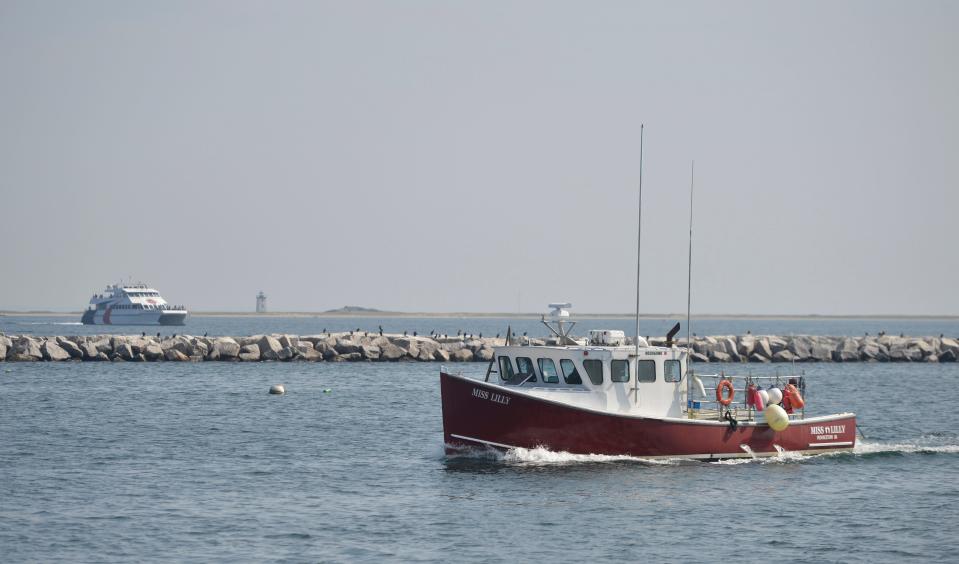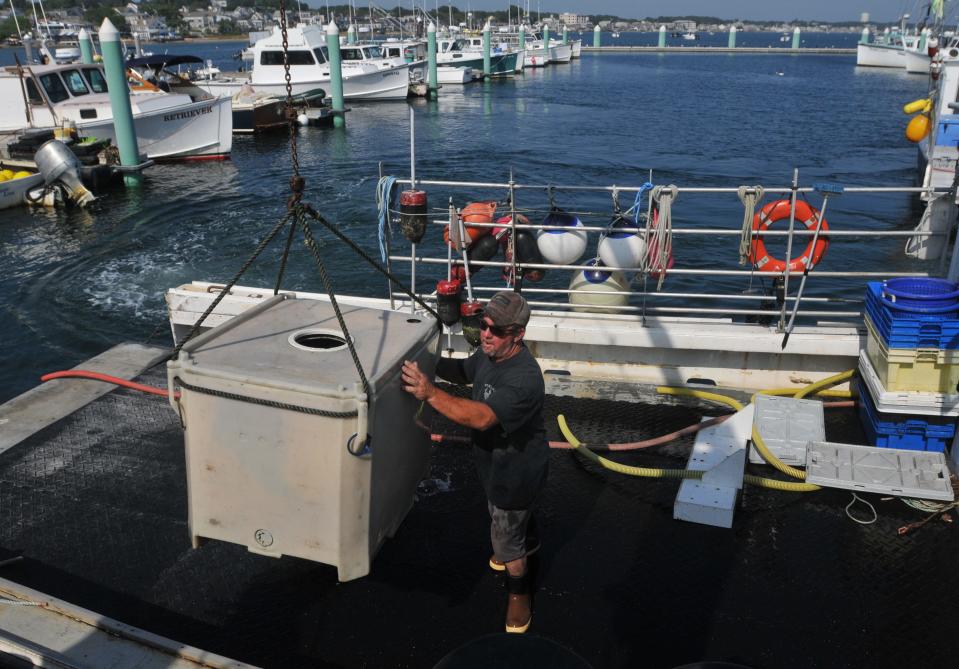Low oxygen areas show up, again, in Cape Cod Bay worrying lobstermen, scientists
For nearly four decades, lobster fisherman Mike Rego has seen plenty of good years and plenty of bad ones.
This one's turning out to be one of the most challenging. There are a lot of juvenile lobsters, "more than I've ever seen," Rego said, and plenty of females with eggs. But the ones he can haul in, the ones that help him pay the bills, are being elusive.
"They just don't seem to settle in," said Rego, who has plied the waters for lobster since he was 12. "They seem to be moving all around. It's like they're in pockets. You have to find them."
As if that wasn't enough of a hurdle, he and fellow fishermen who make their living on Cape Cod Bay are once again contending with low dissolved oxygen, or DO, zones in the water body, which can suffocate animals unable to move out of them. It's the fifth consecutive year these conditions have formed in the bay, prompting the Massachusetts Division of Marine Fisheries recently to issue an advisory to lobster trap fishermen and others.
During a recent trip out on his boat, Miss Lilly, to collect the traps he'd set on the Billingsgate Shoal off Wellfleet, "everything was dead," said Rego. On the silver lining side, none of the dead animals in his traps were lobsters.
"It was mostly crabs, and a couple of fish," he said.
But it still concerns Rego, who typically fishes from Provincetown down to Wellfleet. The low dissolved oxygen anomalies scientists and the fishing community have been watching closely for four years now are "happening more and more," he said. And those conditions are showing up all over the bay, not just in the southern regions.
"The bottom gets all black, and it smells," Rego said.
Rego is part of the Cape Cod Bay Study Fleet, a partnership between the Massachusetts Lobstermen's Association and the state Division of Marine Fisheries. The state provides participating lobstermen and women with oxygen probes they attach to their lobster pots to gather measurements from the bay floor, with a goal of monitoring bottom dissolved oxygen and to issue warnings when low dissolved oxygen, or hypoxic, areas are detected.

In mid August, Marine Fisheries issued a warning that sensors deployed by the study fleet, and by the Center for Coastal Studies — which is also cooperating with the agency — once again detected low dissolved oxygen zones in the bay. Data showed levels less than 4.0 milligrams of oxygen per liter at a number of locations in the northeast part of the bay, between Provincetown and Wellfleet, as well as in the southern region north of Barnstable.
What is low dissolved oxygen in Cape Cod Bay all about?
According to the state marine fisheries division, "values less than 4.0 mg/L are considered mildly hypoxic, and values less than 2.0 mg/L are considered severely hypoxic."
"These low values of DO that we’ve observed are concerning, particularly since it is relatively early in the season compared to the timing of previous years," the agency's advisory stated.
Areas of low dissolved oxygen continued around parts of the bay as of Wednesday, both in the northeast and the south, according to an interactive map on the state marine fisheries website.
"It's kind of been a bummer," said Rego, whose task has been not only to find lobsters, but also to find out "where low oxygen is not."

How do the low oxygen monitors in Cape Cod Bay work?
He has five oxygen loggers to distribute among his 800 pots. He can retrieve data from the loggers on a computer aboard his boat, but he first has to pull them from the water. Besides looking at the data he collects and shares with the state marine fisheries division, Rego also keeps tabs with other fishermen to "get an idea where they (low dissolved oxygen areas) are."
What's frustrating, Rego said, is a low zone "could be at one spot one week and the next week it's elsewhere."
Low dissolved oxygen in Cape Cod Bay presents worries for others too
The low dissolved oxygen anomalies aren't just capturing the attention of the fishing community. People monitoring environmental changes owing to a warming climate and advocating for action to reduce its effects are concerned, too. Among them is Andrew Gottlieb, executive director of the Association to Preserve Cape Cod.
"Clearly, this is indicative of some baseline change in environmental conditions," Gottlieb said. "Obviously, it's a big deal, not only for the lobstermen, and just also ringing a bell that we have water quality problems in that large body of water. It's a big concern."
Besides affecting trapped animals like lobsters, fish and crabs, low dissolved oxygen also affects shellfish "that are pretty stationary," he said — a particular concern for the Cape's oyster and clam fisheries.
The physical dynamics of the low dissolved oxygen zones are much like the fresh water ponds where you get this thermocline — the separation between warm upper layers and colder deeper layers, Gottlieb said. Over time that thermocline becomes thicker, more stable and longer lived and it isolates poorly oxygenated water below from the oxygenated water above, he said.
"Certainly, the warming of our waters, both on the marine side and the ponds, have shown early formation of thermoclines and more durable thermoclines than historically have been seen," Gottlieb said. "It's fair to say rising water temperatures in combination with rising air temperatures are contributing factors."
Conditions in Cape Cod Bay have changed in favor of a type of algae first detected in 2017, according to research
The state marine fisheries agency highlights research done by the department's Invertebrate Fisheries Project Leader Tracy Pugh, and Malcolm Scully, an associate scientist at Woods Hole Oceanographic Institution that theorizes conditions in the bay have changed in favor of a type of algae called Karenia mikimotoi, which was first detected in the bay in 2017.

"Unlike many of the species more commonly found in the bay, K. mikimotoi is adapted to low light conditions and can vertically migrate, allowing it to use the nutrient-rich bottom waters present during late summer," according to the state agency.
That, combined with rapidly warming water, which holds less oxygen, and changes in seasonal wind patterns, are at the heart of the problem, they hypothesize.
Amy Costa, director of the Water Quality Monitoring Program at the Center for Coastal Studies, leads a team that monitors low dissolved oxygen conditions in the bay. They regularly run north to south transects in areas of concern, with stations spaced half a nautical mile apart. At each station, they use a data logger equipped with a dissolved oxygen sensor, fluorometer, temperature, salinity and depth sensors.
"It’s lowered all the way to the bottom, providing a profile of the entire water column," Costa said.
Other factors that play a role, Costa said, are downwelling and upwelling events, and the strength of the stratification gradient between warm and cold water layers. The low dissolved oxygen zones occur, she explained, "after the water column has stratified," typically late summer and early fall.
She said the first time her team was made aware of the low dissolved oxygen zones was also in 2019, and they've been working with WHOI and the state marine fisheries agency since then to monitor for hypoxic conditions.
Baseline bottom dissolved oxygen conditions, she said, have been lower than usual over the last few years based on the data collected from a long-term monitoring program, she said, "so I’m fairly certain hypoxia hasn’t been a common occurrence before these past few years."
First signs in Cape Cod Bay were in 2019 for Massachusetts lobstermen
Massachusetts Lobstermen's Association Executive Director Beth Casoni said the first alarm bell rang for the organization in September 2019, as it did for scientists, when fishermen began pulling up hundreds of pounds of dead lobsters, crabs and fin fish in traps, as well as dead shellfish, from the southern reaches of the bay. Casoni describes the conditions that form as "almost like a fish tank with no air hose."
Hypoxic conditions reappeared in 2020, and again in mid-August 2021 — earlier than previously, though less severe. That year, the problem showed up in the north and east portions of the bay, near Wellfleet, where the lowest dissolved oxygen was observed, and mild hypoxia again showed up in southern areas from Sandwich to Barnstable.
Now, Casoni said, "we're monitoring it more." The collaboration, she said, "gives us an ability to get the message out to our industry so they can move their gear away from low DO areas" and is giving them a better picture of conditions that lead to hypoxic events.
The program, she said, has so far helped avoid the high mortality experienced in 2019, still considered the most severe. This is particularly important for the lobster fishery, which Casoni called one of the "most valuable" resources in state waters.
How long do low dissolved oxygen conditions last in Cape Cod Bay?
Low dissolved oxygen conditions usually last several weeks. They can break down if the wind is right or there are particularly turbulent storms that get the water column circulating, and generally fall apart when air and water temperatures are cooler in the fall and winter. But with climate change extending warm seasons, and the Gulf of Maine recognized as the world's fastest-warming water body, low dissolved oxygen could appear more often and linger longer.
The state marine fisheries division recommends fishermen check traps frequently, and consider moving their gear when necessary. Low dissolved oxygen conditions, the agency warns, "can change rapidly based on weather conditions — wind and waves."
The right kind of wind is just what Rego hopes for these days.
"Hopefully we get some good wind here," he said, "to roll it all over." But while he waits, he's taking his traps and doing a lot of what the lobsters seem to have been doing: Moving around.
Heather McCarron writes about climate change, environment, energy, science and the natural world. Reach her at hmccarron@capecodonline.com.
Thanks to our subscribers, who help make this coverage possible. If you are not a subscriber, please consider supporting quality local journalism with a Cape Cod Times subscription. Here are our subscription plans.
This article originally appeared on Cape Cod Times: Study ongoing, new warning about low dissolved oxygen in Cape Cod Bay

